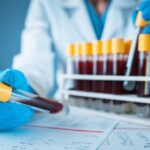
Scientists have taken a major step towards developing a blood test that could identify millions of people, who spread Tuberculosis (TB) unknowingly.
Millions of people are spreading tuberculosis unknowingly but scientists say they are close to developing a new test that is as simple as the lateral flows used during the COVID pandemic. A breakthrough study has discovered a group of biological markers that are found at high levels among infectious patients.
The researchers hope the findings will pave the way for a simple test that can diagnose and stop the spread of the estimated 10 million cases yearly. Tuberculosis is the world’s deadliest infectious disease and kills more than one million people each year, according to World Health Organisation data.
Scientists from the University of Southampton, working with experts worldwide, carried out the most detailed analysis ever undertaken of blood markers for the bacterial infection. The study, published in the Journal of Clinical Investigation Insight, used a novel technique that identified a set of six proteins that are highly accurate in pinpointing TB.
Lead author, Dr Hannah Schiff, and a respiratory expert at Southampton, said as many as three million cases were missed last year, mostly in developing countries. She added: “TB remains a global catastrophe because our efforts to control the spread are hindered by inadequate testing, which is slow and reliant on specialist equipment and labs.
“A third of people who get infected go undiagnosed and remain infectious. In our study, we combined a new measurement technique with deep mathematical analysis to identify these six new markers of TB disease. It could lead to a transformative alternative to diagnosing the condition — a simple test that detects proteins in the bloodstream whose levels differ between people with TB, healthy individuals, and those suffering from other respiratory illnesses.”
TB spreads through inhaling tiny droplets from coughs or sneezes of infected people — and, while it mostly affects the lungs, it can devastate any part of the body. Cases in the UK increased to around 5,000 last year, and are expected to continue rising in 2024, according to the UK Health Security Agency.
The University of Southampton study was undertaken with experts from the University of Cape Town in South Africa and Cayetano Heredia University in Lima, Peru.
It was published for World TB Day, on 24 March, which is held to raise awareness and to step up efforts to end the global Tuberculosis pandemic.
The study was funded by the UK Medical Research Council and the National Institute for Health and Care Research (NIHR) Southampton Biomedical Research Centre. Academics leading the investigation studied proteins found in the blood of people with active TB in Africa and South America.
They compared the biomarkers to those found in healthy people and patients with lung infections, identifying 118 proteins that differed significantly between the groups.
The experts then narrowed these down to the six proteins that, they said, can be used to distinguish contagious patients with TB from people in good health or with lung conditions. The findings are a roadmap to developing a TB test that is as simple as the lateral flows used during COVID, said study co-director Dr Diana Garay-Baquero, also from Southampton.
She added: “The new markers we discovered are truly exciting, but the important work now is to develop these into tests that can be used for the millions of people who are transmitting TB without knowing it. As the Covid-19 pandemic confirmed, we ignore highly infectious airborne diseases at our peril.”
Acting Board Chair, Stop TB Partnership Nigeria, Dr Queen Ogbuji-Ladipo, confirmed to The Guardian that some people habour the TB infection and are spreading it without knowing.
She noted that the International Office on Migration (IOM) also informed the organisation that some Nigerians, who migrated abroad in search of greener pastures, harbour the infection but do not have the disease.
“So, you see them looking well but when you do the test you will find out the tuberculosis is hiding there. For such people, just having something that lowers their immunity, the disease will come out, but they won’t know that they have been harboring it. That is the good thing with the protection we give children at birth, when we eat well, are not stressed, and don’t have any other diseases that we call co-morbidity then most people are protected.
“That is why when we have somebody that has the disease in the house, we protect the other members of the family with that TB preventive treatment that we call Tpt to protect the whole family so that while you are treating somebody that has the disease, those people are infected because the disease is not showing signs and symptoms will also be protected and won’t come down with the disease.













